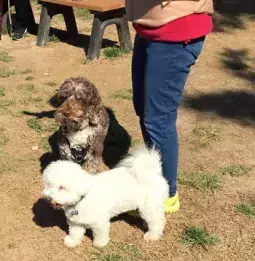Boomer Unchained: Is Your Dog a Vegan? Mine Loves Beef.
They used to say, “the best way to a man’s heart is through his stomach.” I never knew if that was true, but it sure seemed to be about the last two dogs I owned.
“Food driven” is a familiar term to us dog folks. Years ago, I had a trainer who told our class to keep a fanny pack filled with the smelliest treats available and the dogs would do anything we wanted.

But feeding dogs (treats included) teeters between art and science, and it can be especially difficult when the dog is our companion, and with us most of the time. It’s keeping “our baby” satisfied emotionally and healthy physically. In other words, it’s knowing what bit of our meal we can share without feeling guilty because we have caused a health problem (For example, the skin from chicken is harmful to a dog because of the underlying fat. Chicken fat causes all kinds of digestive issues, some of which can be serious).
When feeding our dogs, we have to give them the right amount of balanced nutrients to be healthy, while avoiding giving them too much, which leads to obesity, and medical problems including diabetes, arthritis and pancreatitis. Maybe that sounds obvious. However, considering more than half of the dogs in the United States are obese1 many of us don’t know how and what we should feed our dog.
Dog food companies want us to believe the kind of food is key to our dog’s health – whether it be vegan, gluten-free, grain-free, organic, grass-fed, raw, dehydrated, or home-made – Take your pick. What have I left out?
The food choice in pet food stores is mind-boggling. I don’t have to tell you. When my dog was alive, I spent more time reading food labels for him than for myself. I regularly checked the FDA website to make sure his food wasn’t recalled.2
I still had questions.
To get a clearer picture, I visited the American College of Veterinary Nutrition’s website. For this article, I also contacted organization member Dr. Edward V. Moser, who has taught nutrition at University of Pennsylvania School of Veterinary Medicine. I am going to summarize here the answers he gave me to four questions I developed through talking to my dog-owner friends Kathy, Pam and Sandy during a visit to the Lewes Dog Park. At the bottom of this blog, I’ve also included some links to the Academy’s website, to the FDA website, and to the ASPCA website.
Feeding Your Dog

Q: How do you know how much to feed a dog?
Generally, dogs are overfed. The amount fed daily depends on how much exercise the dog gets and how many calories it needs for its weight. Small dogs require more calories per pound than large dogs. You can’t depend on measuring food because weight and density of the calories and nutrients need to be considered – canned food, which includes water, has less nutrients and calories per its weight than kibble. Kibble can be airy (fewer calories) or dense (more calories). So, a ‘cup’ is not just ‘a cup.’
-
- Weigh your dog to establish a baseline, and weigh him regularly. The ribs should show on a healthy dog (like people). Consult your vet about your dog’s optimum weight and food intake.
- Read dog food labels to understand how many calories are in a cup of your food, as well as whether the food offers a balance of nutrients. All commercial foods are supposed to meet FDA nutritional standards.
- Write down the date you open a bag of dry dog food and measure how much you are using – this will tell you how much you are feeding your dog, which may surprise you.
- As far as how often to feed: Studies have shown the feeding twice a day instead of once a day is easier on the dog’s GI tract and young, old and sick downs do better with smaller amounts of food more than once a day.
- Once you have established optimum calorie intake, don’t forget that treats have calories, and that the ‘optimum’ amount changes with lifestyle changes.
- Table scraps – These effect the overall calorie intake. Unfortunately, many of them are rich (have fat) which dilutes the amount of nutrients contained in commercial food, or the food you may be making in which you add supplements. Scraps add unnecessary calories. Some can be unhealthy (See link below)
Q: What about vegan and gluten-free foods?
Commercial pet foods are required to meet certain nutritional standards and so vegan, gluten-free foods, or those containing meat, chicken or fish should provide equal nutrients. Follow the caloric intake guidelines noted above. The difference between these ‘trendy’ foods lies in what the dog likes, and whether the dog has health problems. For example, for some reason, dogs with certain health conditions do better on gluten-free foods. Consult your veterinarian for special diets for health conditions.
Q: What about raw food?
Raw food is the exception. The American Animal Hospital recommends NOT feeding raw meat to dogs. There are several health and risk reasons, including the risk of serious illness to the dog, and to humans who come into contact with the dog and its feces.
Q: What about grain-free food? I’ve heard there is some controversy.
While the FDA and others continue to study whether grain-free food can lead to certain heart problems, this risk has not been confirmed and so commercial, grain-free foods continue to be safe and do not require the owner to add supplements (for a healthy dog).
Consult your Veterinarian when your dog as any medical problems. I hope this bit of information offers some light to all the chatter around us about what our dogs are supposed to eat. I also want to thank my friends Pam, Sandy and Kathy for discussing dog food issues with me for this article (See their dogs).
Helpful websites for feeding your dog:
American College of Veterinary Nutrition: Frequently asked questions: http://www.acvn.org/frequently-asked-questions/
Foods dangerous for your dog: https://www.aspca.org/pet-care/animal-poison-control/people-foods-avoid-feeding-your-pets
FDA Animal food recall website: www.fda.gov/AnimalVeterinary/SafetyHealth/RecallsWithdrawals/default.htm
- The Association for Pet Obesity Protection. https://www.aaha.org/pet_owner/lifestyle/obesity-in-pets.aspx
- FDA dog food recall announcement. https://www.fda.gov/AnimalVeterinary/NewsEvents/ucm634138.htm

